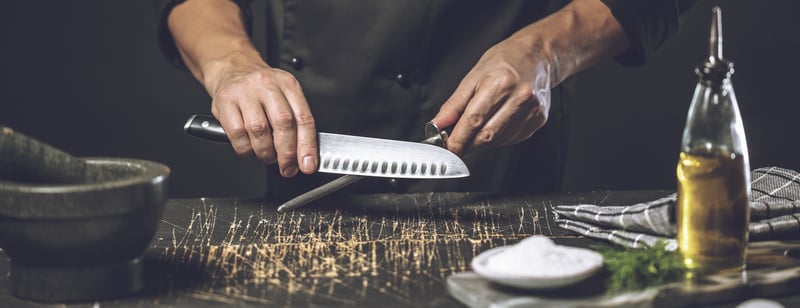3 knife skills videos to help slash food waste

One of the biggest sources of food waste is trim waste from fruits, vegetables and meats. Some trim waste is inevitable. For that, try to repurpose using my guide to repurpose commonly wasted foods. But some trim waste is created because of poor knife skills: a quarter of a bell pepper is left on top, meat comes off when fat is trimmed. Teaching proper knife skills is critical. Find out the chef on your team who is best with knives and have him or her give a tutorial. Short of that, we've collected some great knife skills videos to help out with teaching the basics.
Knife Sharpening
The guy in this video is a master. That is the exact way I sharpen my knives. It takes hours of practice but over time, anyone can have the sharp knives they need to be effective and efficient in the kitchen. Sharp knives are so very important when preparing food as they allow the cook/chef to prepare foods quickly and safely. Sharp knives also help save food by not damaging it during prep. A dull knife will have a tendency to “smash” the food instead of cutting it, leading to food that is sometimes tossed away because it does not look appetizing. The right knife for the right task is also essential – so if you have the right knife, and it’s sharp, you will be more apt to prepare food correctly in your kitchen.
Knife Grip
Confidence is all about being comfortable with your knife, the grip and your cutting motion. A good grip and cutting motion allows you to prepare the food correctly – whether it be cutting a mince, dice, julienne, or brunoise. Holding the knife properly will prevent arm fatigue as will a sharp knife. If you have proper grip, it’s less effort and it’s safer – you will have more confidence in the kitchen to prepare foods correctly.
Common Cuts
Learning these common classical knife cuts is a must for any chef. The common cuts allow food to be cooked evenly and with aesthetic appeal. Of course, when preparing these cuts there will be a good amount of trim waste. The key is to reprupose this trim waste in dishes – soups, stocks, stews, purees, casseroles – that don’t necessarily call for exact cuts.
For more best practices on reducing and re-purposing food waste we’ve compiled 20 helpful food waste-cutting tips from our clients and Leanpath coaches. Download your copy of the e-guide below!
